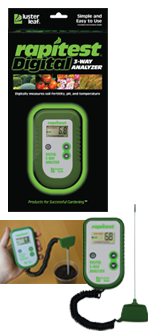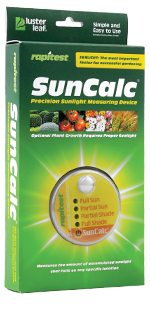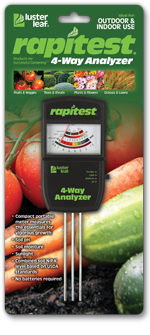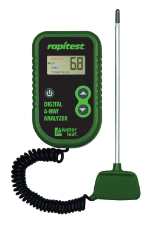products
Download Full Catalog (pdf)
- 1836 - Digital 3-Way Analyzer
- 1875 - SunCalc
- 1875 - Video
- 1875 - About
- 1875 - How
- 1875 - Why
- 1875 - FAQ
- 1880 - Electronic 4-Way Analyzer
- 1885 - Digital 4-Way Analyzer
 Catalog: 1836
Catalog: 1836
Digital 3-Way Analyzer
3 per case.
The Digital 3-Way Analyzer provides gardeners the ability to easily test and read soil pH, fertility and temperature.
Quick Download:
1836.jpg
1836_out.jpg
1836_inuse.jpg
 Catalog: 1875
Catalog: 1875
SunCalc
6 per case.
Quick Download:
1875.jpg,
1875_inuse.jpg,
1875_alone.jpg
SunCalc measures the amount of accumulated sunlight that falls on a specific garden location. The patented electronic process provides the ability to match a plant's light requrements (full, partial sun, partial shade, or shade) with the actual sunlight conditions. Most gardeners contend with a series of micro-climates (relative to sunlight) on their property. The path of the sun, the effects of shade trees, shadows produced by the house, outbuildings, fences, etc. all contribute to varied maount of available sunlight. By using the SunCalc gardeners can accurately measure the amount of photosynthetically active light in a specific location.
Catalog: 1875
SunCalc - About
One of the leading gardeners supply catalogs used an excellent quote to describe the introduction of SunCalc. "This is a great new why didn't I think of that? tool that should be part of every gardener's kit."
All plants require some level of sunlight in order to grow and thrive.
Plants capture the energy in sunlight and convert it into different forms of chemical energy. The process by which this happens is call photosynthesis.
Lawn and Garden Centers arrange all plants for sale according to the plants optimum sunlight requirements.
Plants for sale have an attached tag or plastic insert in the pot that provides consumers with information on planting instructions and plant care.
The most prominent feature of these tags is a reference to optimum sunlight exposure required by the plant... the universal designations are Full Sun, Partial Sun, Partial Shade, or Full Shade light conditions.
Prior to the invention of SunCalc "the sunlight calculator" the decision as to where to place plants ranged from an educated guess (by professionals) to plant and hope for the best (by the average home gardener). There was no effective way to determine the actual amounts of available sunlight at a specific property location.
SunCalc "the sunlight calculator" is a revolutionary new electronic solar radiation measuring device that accurately measures photo-synthetically active (PAR) sunlight.
SunCalc is unique. There is no comparable product.
SunCalc features a photo receptive diode that collects sunlight/solar radiation then converts it into electric current. The electrical current is sampled by a microprocessor using an algorithm that measures light intensity over a period of 12 hours.
Catalog: 1875
SunCalc - How
SunCalc has been in development for a number of years. Our goal has been to give gardeners and landscapers a precision instrument that is affordable and easy to use.
STEP 1:
Select a day when you can reasonably expect a full day of sunlight.
STEP 2:
Start early in the day (7-9 am). Place the SunCalc in the desired location for evaluating the amount of available sunlight. We recommend that the unit be placed in a flower pot
filled with soil, but it can also be placed directly in the ground. Please make sure that the face of the unit is generally parallel to the ground. We want to make sure that the SunCalc is
measuring the sun's rays in the same way that the plant's leaves receive the sun.
STEP 3:
Press the power switch located on the shoulder of the device to turn the SunCalc on. When the power is applied, the Full Shade through Full Sun LEDs will illuminate sequentially for
approximately 2 seconds.Thereafter, the four LEDs will flash every 2 seconds, indicating the sunlight accumulation is in progress.
STEP 4:
After 12 hours of continuous operation, the device will cease to accumulate solar data and a single LED will illuminate to indicate the light threshold achieved in that location.
Full Sun, Partial Sun, Partial Shade, Full Shade.
IMPORTANT:
1. The Sunlight Calculator must remain on for a minimum of 12 hours in order to achieve a light threshold reading.
2. Do not store your Sunlight Calculator in temperatures below 32 degrees. Freezing temperatures will significantly reduce battery life.
3. The Sunlight Calculator is a precision measuring device and should be used only as directed. Depressing the on/off button in rapid succession for long periods could affect the units
operating system and cause the unit to malfunction. Should this occur, remove the SunCalc battery for 10 seconds, then reinstall and restart the unit.
4. Water-resistant... not waterproof. Rain or sprinklers will not affect the unit's operation. However, do not submerge unit in water.
5. SunCalc is designed to calculate sunlight conditions during the planting/growing season.
NOTE: The device will shut itself off after 24 hours of operation but the data measurement will be retained in memory. The last light threshhold achieved can be retrieved from memory
by turning the power switch on.
Keep out of reach of children.
Trade mark registered.
Catalog: 1875
SunCalc - Why
Most gardeners have to contend with a series of micro climates (relative to sunlight) on their property. The path of the sun, the effects of shade trees, shadows produced by the residence, outbuildings, walls and fences, all contribute to a varied amount of available sunlight. Using SunCalc gardeners can accurately and easily measure the amount of photosynthetically active (PAR) light in a specific growing location. All gardeners need to do is place SunCalc at the desired location, turn it on and 12 hours later return to read the results... Full Sun, Partial Sun, Partial Shade or Full Shade.
You've made a substantial investment in your gardens and landscape. Don't let the wrong light conditions spoil a beautiful garden. Put your plants where they want to be.
Catalog: 1875
SunCalc - FAQ
Q. WHY IS SUNLIGHT SO IMPORTANT FOR PLANTS?
PHOTOSYNTHESIS. All plants need light to grow and flourish. Plants capture the energy in sunlight and then convert it into different forms of chemical energy. This is called photosynthesis, which literally means “making things with light”. Plant leaves are like small factories that produce food for the plant. They contain a green pigment called chlorophyll. Think of chlorophyll as an energy capturing substance that uses sunlight to convert water and carbon dioxide into oxygen and glucose or sugar. This sugar is then mixed with water and is sent throughout the plant where it is used as food. It’s an amazing process that sustains life and makes the correct amount of sunlight vital to your plants’ survival and ability to flourish.
Q. WHEN WE TURN SUNCALC ON HOW DO WE KNOW IT’S WORKING?
When power is applied by pressing the power switch the Full Shade through Full Sun LED’s are illuminated sequentially signifying the microprocessor has stabilized. Each LED illuminates in sequence from bottom to top. The unit is on. All 4 LED’s flash once every 2 seconds during the 12 hour cycle indicating that solar energy accumulation is in progress. After 12 hours of continuous operation , the unit will cease to accumulate solar radiation data. A single LED representing the sunlight threshold achieved will flash every 2 seconds for the next 12 hours unless the unit is turned off. In the event you wish to turn the unit off prior to completion of the normal 12 hour accumulation cycle, press the power switch again and the Full Sun through Full Shade LED’s will illuminate sequentially from top to bottom and unit turns itself off. No solar energy reading will be recorded. If after attaining a valid reading ( 12 hours of continuous operation) you do not turn off the unit it will stay on for an additional 12 hours displaying the current reading. At the end of 24 hours the unit turns itself off. No further indication of activity is present and the last reading will be saved until the unit is turned on again.
Q. I USED THE SUNCALC ONCE WITH GOOD RESULTS. WHEN I TURNED IT ON TO USE IT AGAIN THE LED THAT REPRESENTS THE LAST READING WAS FLASHING, HOW DO WE RESET IT?
Resetting the unit is automatic. When you turn the unit on after having attained a valid reading the LED that represents the last reading will flash for about 7 seconds….then the unit will automatically reset and resume collecting solar energy. This feature is designed into the units program to prevent gardeners from losing the last reading by forgetting it.
Q. SOMETIMES PLANT TAGS SPECIFY HOURS OF SUNLIGHT REQUIRED PER DAY. HOW DOES TIME RELATE TO SUNCALC READINGS?
SunCalc is programmed to calculate the aggregate amount of full intensity solar energy that falls on a specific piece of property during a (12) twelve hour period.
SunCalc readings are related to time as follows :
Full Sun - 6+ hours
Partial Sun - Less than 6 and more than 4 hours
Partial Shade - Less than 4 and more than 1 1/2 hours
Full Shade - Less than 1 1/2 hours
Q. WHY IS IT RECOMMENDED TO PLACE SUNCALC IN A FLOWER POT WHEN MEASURING LIGHT CONDITIONS?
When placed directly in the ground, the SunCalc unit be approximately 5 inches above ground level. If the area to be measured has existing plantings, the SunCalc unit could be shaded by these plants. Putting the Suncalc unit in a flowerpot of appropriate height will insure that the face of the unit will be level and will be unobstructed by existing plant foliage. Additionally, the SunCalc unit in a flowerpot will be more visible and less likely to be disturbed or damaged by accident.
Q. IS THERE AN OPTIMAL TIME OF YEAR TO TAKE SUNCALC READINGS?
YES. SunCalc is designed to measure the amount of solar energy available during the growing season. In most of the continental United States the”growing season” is during the months of April to August. Extreme southern locations of the US may have an extended season to include March and September. Generally, Canada has a growing season of May to August.
NOTE: We have included an outlined Solar Energy Data Set for your reference in these links:
Isolation Levels US ( PDF )
Isolation Levels Canada ( PDF )
Levels of optimum intensity solar energy for the plant growing season range from readings of 4.85 + to 7.00+.
 Catalog: 1880
Catalog: 1880
Electronic 4-Way Analyzer
3 per case.
Unique three probe design allows one meter to measure the essentials for plant growth: sunlight, soil pH, moisture, and combined N-P-K levels.
Quick Download:
1880.jpg
 Catalog: 1885
Catalog: 1885
Digital 4-Way Analyzer
3 per case.
• Test for Soil pH, Moisture, Light and Temperature
• Modern digital output for easy reading
• Corded probe makes it easy to handle and read output at same time
• Simple and thorough instructions included along with full guidelines and gardening tips
• Full pH plant list included for 450+ plants from Rapitest - the leaders in home soil testing
Quick Download:
1885.jpg


